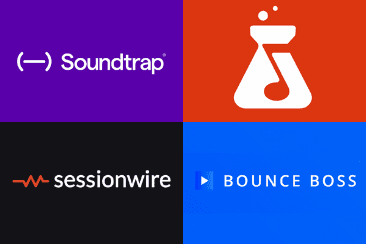If you are making original music, you have probably heard people talking about making a demo. The demo track has been a constant in music for decades and is a cornerstone of an artists’ output. In this blog, we’ll define what is a demo in music, the process of making one, and how to use demo music.

What is a Music Demo?

In short, a demo is a sketch or ‘draft’ version of a song recorded to demonstrate to interested parties how the song should go. Interested parties could be a producer for the next record, other musicians or songwriters who might work with the track, management, or any other folks who might get involved with the song.
Why Artists Should Make a Music Demo

There are lots of really good reasons for an artist to make a demo, including:
Refining Ideas
When recording a demo, artists force themselves to take that great chorus they’ve written and build a song around it. In many cases, this can help make creative choices around how a song goes, and realize how it should sound or what makes sense on the track.
Remembering Songs
For prolific songwriters, it can sometimes be hard to remember the ideas they have – making demos as they go means that there is a handy file that outlines all of the ideas. It can be a really useful place to have when looking for a good verse, chorus, or bridge at a later date. Some songwriters even organize their demos by mood, lyrical themes, which artists they think will like the song, etcetera, so information is easily findable when they come back to it.
Capturing Ideas
A demo of a song can be an awesome tool if writing songs alone or collaboratively, especially if there is a lot of writing. By running a tape and recording ideas at the moment, artists capture the rhythm and magic of how a line is delivered. This is sometimes lost when the song is revisited. If creatives are writing together, being able to capture a simple demo not only accurately captures the idea, but also helps to document changes that are agreed on during a writing session. This can make the songwriting process much more efficient as it saves having to try to remember all the little changes, and re-clarify once all the writers are back in the same room later.
Preparing For The Studio
This is probably the most common – and arguably the most useful – application of the music demo. Recording demos of the tracks to be included on an album ahead of a full studio session allows bands to become comfortable with the process of recording. Also, to float ideas about things that can be added to tracks without running up a huge studio tab, and even work with the demo recordings for a while to make sure the songs and recordings work properly. Things like instrumentation and BPM can all be considered in advance so the time in the studio is focussed on executing the vision rather than trying out lots of different (and expensive) ideas.
In a modern setting, where bands are making demos in their own home studios before going into a pro studio, there is an extra benefit in that the bands learn a significant chunk of the recording process themselves. This means that when recording, they can approach the record with an understanding of how to best perform, in order to capture the sound for recording so the time in the studio is used effectively – and of course, this paves the way for little touches to be made from those home studios and added to the full studio project retrospectively if needed.
Capturing The Moment
This might seem like an odd one to reference but it is significant. When artists make a demo, they are generally early in the songwriting process and as such, there is a certain excitement and intensity that goes along with a song. The song is very recently, or even still in the process of being, created. Sometimes artists just nail that first demo in a way that they can’t capture later – the opening notes of The Rolling Stones ‘(I Can’t Get No) Satisfaction’, the whistling in Otis Redding’s ‘(Sittin’ On) A Dock On The Bay’, and ‘Idioteque’ by Radiohead were all demo recordings that were dropped into the final production.
Sending A Demo To Music Industry Members
Whilst it’s fair to say that the days of being signed after sending a demo into a record label are pretty much gone, the demo still has a really important place when it comes to sharing ideas with people in the music industry.
When it comes to booking gigs, it can be useful to share demo recordings with venue owners so they can get a flavor of the sound. It can also be really helpful to share demos of songs with labels and management to give them an idea of the creative direction of the next project, so they can start thinking about the best approach for marketing and promotion of the record. Similarly, as highlighted above, giving a set of demo recordings to a producer ahead of a recording session can help them make creative suggestions around the recording process, but also around the song and how it can be tweaked before a band heads into the studio and starts paying by the hour.
How To Make A Music Demo

When it comes to making an effective demo, the first question is: what is the purpose of the demo? Is it simply to record or remember ideas? To send a melody idea to a collaborator? Or do is it to have something a little more refined than can be revisited?
What Is Needed To Make A Demo?

If an artist is in the songwriting process, and just wants to remember an idea they have had, the best recording tool is a phone. Get that iPhone out and record the idea – it can always be refined later.
For a slightly higher production value that can potentially be shared as a more coherent idea with others, then artists will need some kind of recording interface. A lot of musicians have pretty well-equipped home studios these days and it’s generally quite easy to get a relatively good setup. A good starting list is:
- A computer with a DAW (Digital Audio Workstation – programs like Pro Tools / Logic / Cubase / etc.)
- A recording interface (there is a wide range of options here but even something relatively cheap and simple like a Scarlett 2i2 is perfect).
- A microphone.
How To Record The Demo

It is good practice to always try to get the best recording quality possible, with the available equipment. Even if there is one microphone and a laptop, good-quality recordings can be made. By educating themselves about microphone placement, recording in a way that minimizes sound reflections, and doing things like recording to a click, artists can achieve a lot with a little.
Being new to the recording process, a good workflow to start is to first record a simple scratch guide track of a song with a click. This generally means one microphone, singing and playing acoustic guitar at the same time, and mapping out the structure of the song. Then play along with that scratch track to add a good take of all the instruments involved, often using MIDI Drums if applicable.
Finally, once happy with the performance, create a mix of the demo and store the final audio file in whichever way suits – a lot of songwriters have a ‘Demos’ folder on their machine under whichever project it is they’re working on, and send to anyone involved in the project that needs it.
Some songwriters like to master their demos or have them mastered by a professional. This does add a cost but it also makes the demo sound much more professional so it becomes a question of what the demo will be used for. If it will be used to pitch to an artist or label, it would be best to get the mix perfect and have it mastered. The track should jump out of the speaker and inspire the listener from the moment they push play. If it is being sent to a producer, or other musicians or songwriters as part of the collaborative process of making a new record, then mixing the record and including some compression or reverb on the stereo output will be enough to give a solid idea of the song.
Where To Send Music Demos

It is important for artists to have an idea of what they want their demo to achieve before thinking about who to send it to. Broadly speaking, there are two types of recipients for a demo tape: collaborators (like producers, musicians, etc) or music business connections (people from labels, management, promoters).
When sending a demo to collaborators, the purpose is to convey the ideas in a simple way for them to learn, or suggest changes that can be recorded properly at a later date. In this instance, the production value doesn’t need to be as high because a full version of the song will be created later – and it’s understood that the demo is simply a way to convey the root idea. As an example, the early working demo of Ellie Goulding’s track ‘Starry Eyed’ has the song as an acoustic track, whereas the final release was more electronic and up-tempo.
On the other hand, if an artist is sending a demo to people in the music industry, then the demo has a different purpose. They will probably want the recipient of the track to take some kind of action, whether that’s a promoter arranging a gig, or a label manager looking to sign the band (or assign the track to one of their artists). The production and performance quality of it is under much greater scrutiny here and it is more important for the demo to sound great.
It would be advisable to record in as high a quality as possible, potentially even at a professional studio. It might also be worth having the demo mastered in order to really make it pop. Aside from the quality of the production, it is also important to note that when sending demos to labels and similar figures within the music industry, there won’t be many chances to have an impact. Make sure that everything around the demo is perfect, and tells the story that it should.
That Was Our Guide Cn Creating A Music Demo!

A music demo is the first step in making great music – just as a graphic artist might make a number of test sketches to plan their piece before they really get to work, a demo allows a musician to reach the full potential of each song. And it’s also a lot of fun to record ideas. The more demos made, the better they’ll get – so have fun with it and don’t be afraid to experiment, that’s what demos are all about!
Are You An Artist?
Get Free Music Distribution and find opportunities to get your music in film, TV, and more through sync licensing. Plus get Music Supervision, Music Publishing, Music Marketing, Artist Development and utilize our Free Artist Websites and Rap Name Generator. Finally, you can amplify your music to those that need to hear it with music promotion, TikTok promotion and professional sharing tool. Why not give the gift of music today with our Gifts for musicians package?
Try all of this out for yourself by joining Мusic Gateway. Get your free trial, no strings attached.










